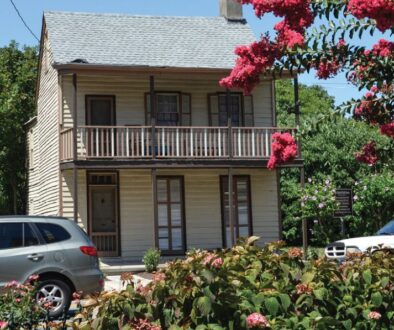The Devil and the Details
It isn’t too likely that Chris Carter, creator and screenwriter for Fox-TV’s The X-Files, had Benjamin Franklin on his mind back in 1993 when he penned the script for Season 1, Episode 5: The Jersey Devil. But in truth, it turns out that the genius behind Poor Richard’s Almanack had more than a little to do with getting the legend of the Jersey Devil up and running.
But we’re getting ahead of ourselves.
In The X-Files version, Fox Mulder and Dana Scully try to track down who (or what) is responsible for the gruesome abduction and murder of a hapless tourist amidst the Pine Barrens:
Scully: They found a body in the New Jersey woods yesterday, missing its right arm and shoulder. They think they must have been eaten off. By a human.
Mulder: Where in New Jersey?
Scully: Just outside Atlantic City.
Mulder: Not an uncommon place to lose a body part.
Okay—when it comes to New Jersey, everybody’s a comedian.
Anyway, in the episode, Mulder and Scully eventually track down the monstrous creature that’s been haunting the Pine Barrens for centuries, namely, the Jersey Devil. (Spoiler alert: the creature they uncover isn’t a monster at all, but a stunningly beautiful Neanderthal woman, played—naked, of course—by Claire Stansfield, a tall, leggy British model and actress. “You should have seen her,” says Mulder. “She was beautiful.”)
Needless to say, by most accounts the Jersey Devil (aka the Leeds Devil) isn’t beautiful at all. The Garden State’s most famous cryptid—designated, semi-officially, as New Jersey’s State Demon back in the 1930s—has been described, in great detail, as kangaroo-like, but with the head of a goat and having large, bat-like wings, horns and hooves, and red eyes. (As you might suspect, descriptions vary.) According to a tongue-in-cheek “A Brief Field Guide to the Leeds Devil” published by the otherwise very serious Pinelands Preservation Alliance, the Devil has a distinctive voice, too: “Voice frequently described as a loud shriek. Also likened to the noise (perhaps only in volume) of a factory whistle. Some observers indicate the call begins as a high, scratchy sound and ends as a low, raspy whisper. Also described as ‘a combination of the hoot of an owl and the snarl of a hyena.’”

While you’re trying to conjure up a hybrid owl-hyena sound, it’s a good time to point out that the Jersey Devil has been the subject of countless books and pamphlets—including a colorful children’s book on sale now at the Emlen Physick Estate in Victorian Cape May—and a number of films, television shows and documentaries. For example, the 2012 horror film The Barrens revealed it in all its gory glory. There have also been many organized monster-hunting expeditions into the Pine Barrens, mostly in and around Galloway Township, and freelance monster hunters over the decades have consistently managed to get themselves lost trekking through the Barrens at night. In fact, it was enough of a problem back in the 1950s that exasperated New Jersey state troopers, concerned that some would-be devil-finders were both intoxicated and armed, hung signs over highways declaring: “The Jersey Devil is a Hoax.”
But it’s not a hoax. At least, not exactly. Like so many legends and myths, the truth about the origin of the Leeds Devil is much more interesting than the make-believe.
And it does involve a young Ben Franklin.
So, just as most science fiction stories, monster movies, and end-of-the-world disaster epics usually include a scientist who explains it all, let’s start with a real-life scientist, or at least an historian of science, namely, Professor Brian Regal of Kean University. Regal—whose biography aptly includes among his research interests “monster studies,… creationism, pseudoscience, the occult, obscuranta and esoterica”—is the acknowledged leader in the field of Jersey Devil expertise. His forthcoming book, Satan’s Harbinger: The Real Story of the Jersey Devil, is scheduled for publication this year.
“My work often deals with the relationship between professional and amateur scientists and historians,” says Regal. “I grew up in New Jersey and I knew about the legend of the Jersey Devil since I was a kid. My colleagues and I accepted that it’s a myth, but we started asking ourselves: Where did this myth come from?”
First, here’s the myth: According to long-buried folklore, the story got its start way back in the 1730s. Somewhere in the Pine Barrens—by vague consensus, it supposedly happened in or around what is now called Leeds Point, part of Galloway Township—a woman called Mother Leeds gave birth to her 13th child, cursing it: “Let this one be a devil!” And sure enough, when it emerged it had the head of a horse, bat’s wings, and gave a high-pitched, bloodcurdling screech. The entity promptly flew up the chimney—but, by some accounts, not before eating its siblings, its unfortunate mother, and her midwife—and proceeded to spend the next three centuries haunting the barrens, killing livestock, and otherwise scaring the bejesus out of countless Jerseyites.
Regal begs to differ. Or, at least, to clarify.
It all goes back to a real-life person, Daniel Leeds, who came to the Garden State in 1677. He had four wives, the first three of whom died. He was a devout Quaker in Burlington, and he served as councilor to Lord Cornbury, the first royal governor of New Jersey, in 1702. By then, Leeds had run afoul of the Quakers, whose leaders were dismayed both by Leeds’ royalist politics and by his apparent penchant for mysticism, odd astrological beliefs, ecstatic “visions,” and other theological quirks that members of the Society of Friends deemed too “pagan.” In his 1688 screed The Temple of Wisdom, Leeds expounded on topics from sorcery to the behavior of devils.
![Japhet Leeds House, Moss Mill Road, Leeds Point, Atlantic City, NJ. Historic American Buildings Survey. Photograph taken by Nathaniel R. Ewan on May 7, 1937. Since Japhet Leeds named 12 children in a 1736 will, his wife has been identied as a possible candidate for Mother Leeds. [Source: Wikipedia]](https://i0.wp.com/www.capemaymag.com/site/wp-content/uploads/2016/11/leeds-house-800x567.jpg?resize=800%2C567)
Photograph taken by Nathaniel R. Ewan on May 7, 1937. Since Japhet Leeds named 12 children in a 1736 will, his wife has been identified as a possible candidate for Mother Leeds. [Source: Wikipedia]
Leeds’ disputes with the Quakers soon escalated into tit-for-tat pamphlets. It wasn’t long before Leeds, who’d begun publishing an almanac, had abandoned the Quakers altogether, converting to the Anglican Church as insults flew; the Friends’ Burlington Meeting called Leeds “evil.” In 1700, the Quakers issued a tract denouncing Leeds, called Satan’s Harbinger Encountered: Being Something by Way of Answer to Daniel Leeds, writes Regal.
In 1716, Daniel Leeds retired, handing over the family’s affairs to his son, Titan Leeds, who had the unfortunate inspiration to redesign the family crest to include three dragon-like creatures, each, records Regal, “with a fearsome face, clawed feet, and bat-like wings.”
You can see where this is going.
Titan Leeds made matters decidedly worse by engaging in an almanac war with a man who, a few decades later, who would become a Founding Father—and whose portrait, after 1914, would grace the hundred dollar bill. As the publisher of Poor Richard’s Almanack, Ben Franklin had little patience for his New Jersey competitor. With the Leeds family already tarred with the sobriquet Satan’s Harbinger and described as “evil,” Franklin and Leeds engaged in a vitriolic back-and-forth, which Franklin viewed with mirth but Leeds appears to have taken quite seriously. Franklin, staying on the theme of the otherworldly, joked that he’d “receiv’d much abuse from the ghost of Titan Leeds.” Except that, as Franklin well knew, Titan Leeds was alive and kicking. In 1738, after Titan Leeds did indeed pass away, Franklin added, “Honest Titan, deceased, was raised [from the dead] and made to abuse his old friend,” namely, Franklin.
Which, as Regal and other historians point out, all happened precisely at the moment when Mother Leeds supposedly gave birth to the Leeds Devil.
Exactly how the legend survived after the 1730s isn’t clear. More than a hundred years after the apocryphal Mother Leeds supposedly birthed a monster, there appeared a brief mention of “the Leeds Devil” in The Atlantic Monthly in 1859, in a piece by a writer otherwise determined to rail against what he called, pejoratively, the Pine Rats who populated the Barrens. Although the historical record is sparse, it seems likely that some word-of-mouth tales of the Devil were passed on by storytellers during the 1800s.
But that all changed in 1909. Triggered, it seems, by pranksters who left fake, cloven-hoof footprints in the soil in South Jersey, Philadelphia-area newspapers, the Trenton Times, and other papers joined merrily in trying to outdo each other with sensational stories about sightings of what was called the Leeds Satan, Flying Hoof, Air-Hos, and Winged Dog before everyone eventually agreed to call it the Jersey Devil. The frenzy reached a peak during the week of January 16–23, 1909, when, according to Wikipedia, there were “hundreds” of reports about the satanic apparition throughout southern New Jersey, Delaware, Maryland, and southeastern Pennsylvania. In some areas, fearful officials closed schools. The Philadelphia Zoo, getting into the act, offered a $10,000 reward for its capture.

Upping the ante, in 1911, proprietor T.F. Hopkins of the quirky 9th and Arch Dime Museum in Philadelphia, and his publicist, Norman Jeffries, engineered a stunt that would raise the Jersey Devil to its place atop the Garden State’s legends. Slapping wings on a kangaroo and throwing the poor beast into a cage, the museum headlined: “Caught!!! And here!!! Alive!!! The Leeds Devil. Swims! Flys! Gallops! … Exhibited securely chained in a Massive Steel Cage.” It was, added the Dime Museum, captured by a New Jersey farmer “after a terrific struggle.”
“The guys who ran the Dime Museum were looking for something to draw the rubes in,” says Regal. “They started hearing these stories, and they think, ‘Jackpot!’ They even staged a monster hunt in the Pine Barrens. And one thing that happens is, people started saying, ‘Oh, I’ve seen that thing in the woods.’”
The rest is history.
Now firmly ensconced in popular culture, the Jersey Devil is likely to be with us for a long time. Paul Pedersen of Franklin Township, author of The Legendary Pine Barrens: New Tales from Old Haunts (2013), says—perhaps tongue-in-cheek, perhaps not—that he first had a close encounter with the Devil on a camping trip as a boy. “I’ve had several run-ins,” he adds, including once when he was a Camden County firefighter and took a report from two terrified women who reported seeing a creature with red eyes, a horse’s head, and a long tail. “I believe people are seeing it, I absolutely do. Too many people have described it verbatim.” A folklorist and singer-songwriter who’s worked with the Pinelands Preservation Alliance, Pedersen is open to the idea that it’s some sort of leftover prehistoric creature. Or, perhaps it all started with a misshapen child born into the Leeds family. Or, he says, maybe it’s a story made up by Barrens moonshiners wanting to scare folks away from their illegal stills.
Beast or myth, the Jersey Devil has become, among other things, a lucrative marketing ploy for tourist agencies looking to squeeze an extra dollar or two out of visitors. Ken Sooy, the official Galloway Township historian, says that Jersey Devil books, artwork and memorabilia are a big hit at the kitschy shops of Historic Smithville. “We’ve had other towns that have tried to steal the legend, to attract tours and such,” says Sooy, wryly.
Was the legend of the devil really the talk of Leeds Point in years past?
“My grandfather, who died in the 1960s, was 90 years old. And he never mentioned it,” says the historian. “But the more alcohol that’s ingested, the better the stories are.” Sooy adds: “It’s the official State Demon, you know.”

Brian Dunning, an author and producer of the popular podcast The Skeptoid, is widely known as a debunker and scientific skepticist who loves to explode urban myths like crop circles, consumer frauds, and ghost stories, as well as purported cures via homeopathy and reflexology. In a 2011 podcast, he said: “In most cases like this, some of the sightings turn out to be mistaken identifications of everyday animals or something else. There is one decent candidate that’s been put forward for the Jersey Devil, and that’s the New Jersey species of the Sandhill Crane. It’s a big slender bird; it can stand tall, and it can spread and flap its two-meter bat-like wings.”
Dunning says that there have always been people willing and eager to swallow the most outlandish stories. “I hear from them all the time,” he says. “Every day I get death threats from people claiming I’m some sort of government shill.” For some people, he says, the Jersey Devil is something to talk about because it’s fascinating, out of the box. But there are those who believe that it really exists, too. “People who honestly believe these stories are people whose brains are just hard-wired that way, who seek to reorganize reality,” he says. “It’s anecdotal thinking.”
Or—is it?



